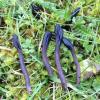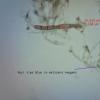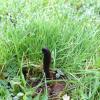
20-12-2025 23:08
Patrice TANCHAUDBonsoir, récolte sur sol sablonneux dans l'arri�

21-12-2025 09:32
Hello.A tiny ascomycete found embedded in wood in

20-12-2025 15:47
Mirek GrycHi.These grew on pine wood that was heavily covere

18-12-2025 21:17
Pol DebaenstThe identification took me to Byssonectria deformi

15-12-2025 07:09
 Danny Newman
Danny Newman
indet. Rutstroemiaceae sp. on unk. fallen leavesMc

19-12-2025 10:10
Patrice TANCHAUDBonjour, récolte réalisée en milieu dunaire, a

18-12-2025 17:23
 Bruno Coué
Bruno Coué
Bonjour,je serais heureux d'avoir votre avis sur c
Geoglossum sp. x2
Andy Overall,
24-12-2014 15:34
Hans-Otto Baral,
24-12-2014 17:35

Re : Geoglossum sp. x2
Hi Andy
I think this need images of more and well-developed spores. I do not know what these spores with constrictions are. They look more like conidia.
Important is to look at living asci. is your material still fresh? Take photos of asci with spores inside, and do not apply any pressure. Then you hjave the chance to see many turgescent asci. It is possible that your first specimen concerns G. fallax. if so the spores must be hyaline inside the living asci and turn brown only a reasonalbe time after ejection (or within dead asci). Most other Geoglossums eject brown spores.
Zotto
I think this need images of more and well-developed spores. I do not know what these spores with constrictions are. They look more like conidia.
Important is to look at living asci. is your material still fresh? Take photos of asci with spores inside, and do not apply any pressure. Then you hjave the chance to see many turgescent asci. It is possible that your first specimen concerns G. fallax. if so the spores must be hyaline inside the living asci and turn brown only a reasonalbe time after ejection (or within dead asci). Most other Geoglossums eject brown spores.
Zotto
Andy Overall,
24-12-2014 18:05
Re : Geoglossum sp. x2
Thanks Otto,
The material is fairly fresh, I have been keeping them in the fridge, would this effect the structures adversely in any way? The first specimen shows dark spores in the ascus, 1st image below, the second, for the second species, shows hyaline spores in the ascus. Would you have any idea as to what the spear-headed looking spores in the ascus of the second image may be? Andy
The material is fairly fresh, I have been keeping them in the fridge, would this effect the structures adversely in any way? The first specimen shows dark spores in the ascus, 1st image below, the second, for the second species, shows hyaline spores in the ascus. Would you have any idea as to what the spear-headed looking spores in the ascus of the second image may be? Andy
Hans-Otto Baral,
25-12-2014 09:25

Re : Geoglossum sp. x2
The left images shows a dead ascus. So this says little.
The tow asci right look alive, so they might eject hyaline spores. I never saw such swollen spore apex in Geoglossaceae. Maybe this is caused by the fridge?
here living asci that eject living spores (G. cf. hakelieri, phot. B. Fellmann).
Zotto
The tow asci right look alive, so they might eject hyaline spores. I never saw such swollen spore apex in Geoglossaceae. Maybe this is caused by the fridge?
here living asci that eject living spores (G. cf. hakelieri, phot. B. Fellmann).
Zotto
Andy Overall,
25-12-2014 11:01
Re : Geoglossum sp. x2
Thanks Otto, thats most useful. Happy Christmas from London :-)










